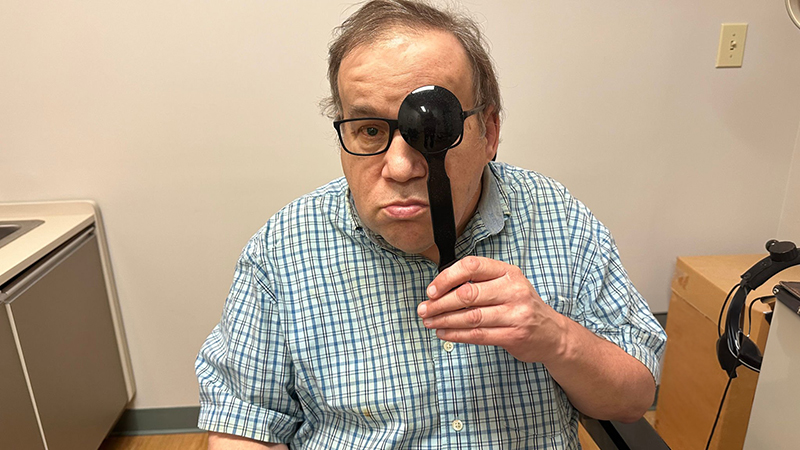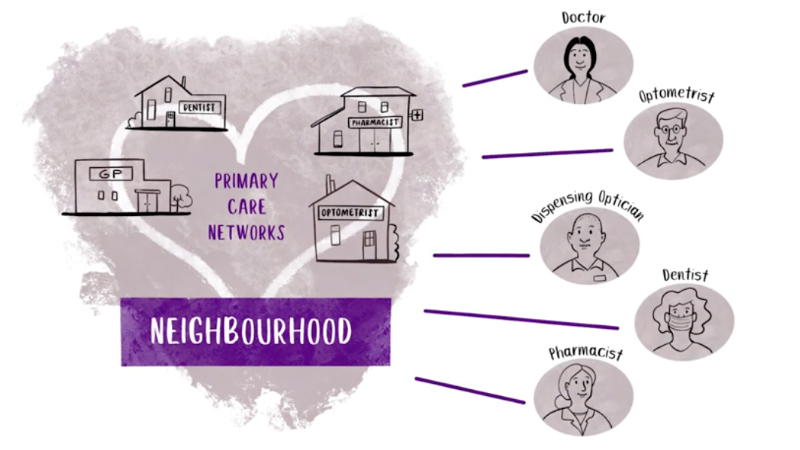Case Studies and Pathways
Paving The Way For Progress in Primary Eye Care

Communicating the ways that LOCs are supporting patients and the eyecare profession is an important part of LOCSU’s role. In 2022–23 we published several case studies highlighting the impact primary eyecare innovation can have on patients, healthcare providers and the NHS.
LOCSU also launched two new primary eyecare pathways, the integrated dry eye disease (DED) pathway and the naevus referral filtering and monitoring pathway. These pathways were designed and developed in close consultation with LOCs, clinical leaders, and strategy groups to ensure they meet the needs of patients, commissioners, and Trusts.
Case studies demonstrate a broad range of eye care services and patient needs.
The case studies published this year cover eye care services for people with learning disabilities, improving IP optometrist access to FP10, low vision, and vision care for homeless people.
Eye Care Services for People with Learning Disabilities in the North West
People with learning disabilities are ten times more likely to have serious sight problems but are less likely to have access to high quality eyecare. Carers and family members may believe the person is unable to complete a ‘standard’ sight test and are not aware that no one is too disabled to have a sight test. LOCSU and SeeAbility have worked together to raise awareness of sight tests for people with learning disabilities, and with WOPEC to update the online learning module to cover autism.
An eye care service for people with learning disabilities has been established in Greater Manchester since 2016, followed by Cheshire and Mersey in 2017. Now, the launch of a service in Lancashire and South Cumbria means that North West is the first NHS region with full coverage in England. Pennine Lancashire LOC and Lancashire Morecambe Bay LOC have worked with SeeAbility to launch the service in Lancashire and South Cumbria. The case study explores how they have approached the task and how the patient community benefits from receiving eye care in a flexible setting closer to home.
Improving Optometrist Access to FP10
The expansion of access to MECS and CUES during and after the COVID-19 pandemic underlined the value of independent prescribing optometrists in treating and managing more conditions to resolution within primary care. However, a LOCSU survey in April 2021 found only 27% of CCGs who had commissioned either MECS or CUES had also enabled access to FP10 prescribing pads, thereby limiting the scope of optometrists to manage a wider range of conditions.
In March 2022, the National Eye Care Recovery and Transformation Programme (NECRTP) published a recommendation to ensure that: “all Optometrist Prescribers have access to FP10 NHS prescription forms.” However, the process for obtaining an FP10 was “complicated and protracted”, taking many months. The case study explores how Primary Eyecare Services (PES) undertook an FP10 review process, with the result that FP10 acquisition now takes as little as two weeks, and looks at the benefits that will accrue as a result.
Low Vision Services Delivered in Primary Care
This case study explores the drivers for and benefits of widespread commissioning of the LOCSU Low Vision pathway.
An ageing population and pressure on secondary eye care means waiting times for low vision assessments can be as long as 24 months. This leaves vulnerable patients in limbo without access to vital support. The case study explores the integrated eyecare service commissioned by East Lancashire Hospital Trust in 2015, including provision for low vision assessments in optical practices, and how this has significantly reduced the time patients wait for help. It also references the Wirral LOC partnership with Primary Eyecare Wirral which has successfully delivered a Low Vision Service for fifteen years.
Vision Care for Homeless People
Homeless people suffer from health inequalities and can struggle to access eye care. This case study explores how a partnership between Vision Care for Homeless People (VCHP), NHS Gloucestershire, Gloucestershire LOC and local practitioners delivered a static clinic at Gloucester City Mission providing General Ophthalmic Services (GOS). 93% of patients seen in the service were prescribed new spectacles and 18% were referred. The case study also highlighted the inequalities faced by homeless people, revealed in figures such as the time between sight tests.
New Care Pathways for Dry Eye Disease and Naevus Referral Filtering and Monitoring
Many LOCs felt that patients with dry eye disease were often overlooked and requested that LOCSU develop a pathway to support this group. Working in collaboration with several LOCs and local stakeholder groups, including the Northeast Dry Eye Guidelines Strategy Group led by Consultant Ophthalmologist Prof. Figueiredo from Newcastle Eye Centre, LOCSU devised the pathway. It fits in the Optometry First Framework, providing first contact care through to resolution and continuity of care for those requiring long term support.
Read more about the Integrated Dry Eye Disease pathway

“By working together to develop pathways and share best practice examples, we continually strengthen the case for delivering a broader range of patient services via primary eyecare.”
Naevus Referral Filtering and Monitoring Pathway
LOCSU worked closely with clinical leaders and LOCs to develop the naevus referral filtering and monitoring pathway. The working group was joined by Professor Bertil Damato, consultant ocular oncologist, who developed the MOLES scoring system that underpins the pathway by helping practitioners differentiate choroidal melanomas from naevi and estimate the risk of malignancy.
The pathway aims to improve the efficiency and accuracy of case-finding of choroidal melanoma to accelerate diagnosis and treatment within the hospital eye service. It also provides for ongoing naevi monitoring where required.
Read more about the Naevus Referral Filtering and Monitoring Pathway
LOCSU’s Clinical Director, Zoe Richmond (above), underlines the importance of collaboration in developing pathways and publishing case studies: “There is a vast amount of expertise within LOCs, and they are optimally placed to devise highly effective care pathways that capitalise on the skills in primary eye care. Additionally, there are numerous best practice examples of pathways being successfully delivered over the long term having measurable outcomes for the patient community and secondary eye care services. By working together to develop pathways and share best practice examples, we continually strengthen the case for delivering a broader range of patient services via primary eyecare.”



